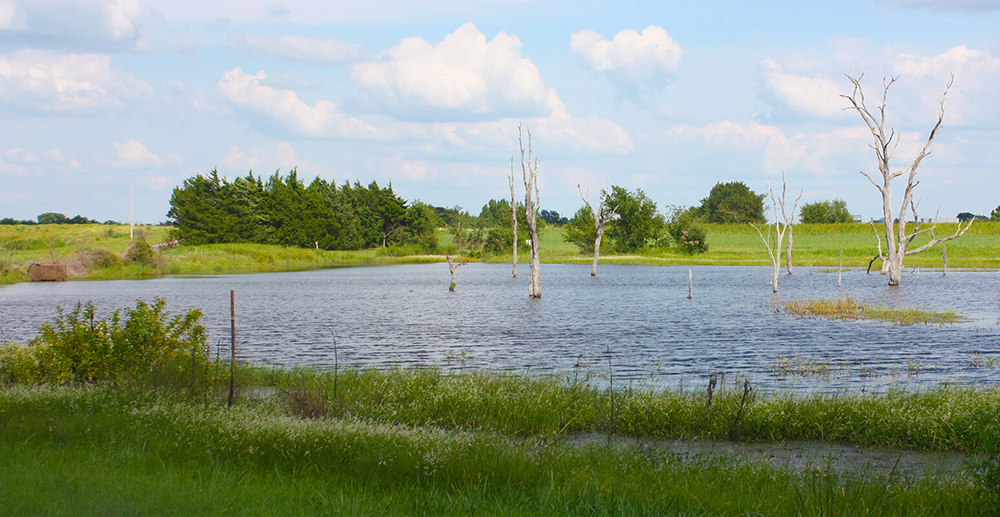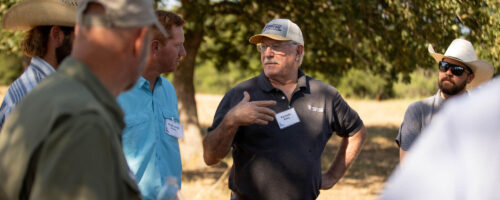Regenerative Ranching Runs Downstream
Land management decisions have consequences – both good and bad – for your ranch’s watershed and the health of your bodies of water.
When you peer into your ranch’s stream, pond or lake, what do you see? Does clear water flow over a rocky substrate teaming with fish, crayfish and other organisms? Or is the water muddied or overrun with algae with only a few water bugs skittering across the surface?
A ranch’s watershed – the land from which water runs off into bodies of water – and its water sources can tell a lot about how the land is managed. Healthy bodies of water reflect proper, regenerative management techniques. As the saying goes, everything runs downstream, which is undoubtedly the case with ranch management, according to Steve Swaffar, ag consultant at Noble Research Institute.
“If you see a lot of bare soil in a native-grass system or along your watersheds, then you’ve probably overgrazed (overgrazing is the same plants being grazed repeatedly without opportunity for recovery), and it’s affecting your entire watershed. If you see a bunch of attached algae on the streambed or rocks that is 30 feet from your cornfield, you’re probably sending a heck of a lot of very expensive fertilizer down that stream,” he says.
As with ecosystems on land, aquatic ecosystems are involved in a constant cycle of complex physical, chemical and biological processes. Any disruptions to these aquatic ecosystems and their delicate cycles have consequences, and there are no quick fixes or “Band-Aids” for an unhealthy watershed — only better management.

Water, water everywhere
As Swaffar points out, most ranches in the Great Plains are limited by water.
“Water is the most valuable resource you have. If you’re not doing everything that you can to capture every drop that falls on your ranch and to make sure that the water is usable, you’re losing value,” he says.
Properly managing your ranch’s watershed is imperative to capturing water. Just consider that for every 1% increase in organic matter, soil can capture up to 25,000 more gallons per acre, per year. That figure is even more mind-boggling when considering how much 25,000 gallons of water would cost if billed through a city water system. Or, as Swaffar points out, many ranchers whose operations are limited by water might just be letting it slip away with improper management.
“Maybe you do have enough water; you’re just not capturing it,” he says.
Luckily, the same management needed to bolster soil health can heal a damaged watershed, it starts with soil cover. Having adequate soil cover along with living roots for as many days as possible allows more water to infiltrate into the soil instead of running off during precipitation events. As the soil absorbs more water and the amount of runoff is reduced, so is the amount of soil and nutrients washed away.
Soil and nutrients swept downstream to the nearest body of water can throw off the precious balance of the aquatic ecosystem. Nitrogen and phosphorus are the two nutrients of primary concern when managing watersheds. Aquatic plants respond to these nutrients like terrestrial plants, and an excess of available nutrients can lead to bodies of water matted with harmful algae or overrun with other aquatic plants.

Unintended consequences
“Every action has consequences, both positive and negative, in the watershed. They may not always see it, but when ranchers make a management decision, it is going to impact their watershed and, ultimately, where the water ends up that’s on their ranch,” Swaffar says.
Ranchers need to limit the amount of soil and nutrients washed into a body of water on their land, he says.
“When we limit the amount of soil being deposited into a water body, water itself is going to be a more diverse place. It’s going to have more species of fish. It’s going to have more species of zooplankton. It’s going to have more types of aquatic vegetation. It will be a more balanced community. And, it’s going to be a healthier resource for wildlife watering, for livestock watering and for all of those species that would be depending on that body of water.
“By applying the soil health principles to the landscape within the watershed, we’re now benefiting that body of water and the species utilizing it.”
An overabundance of aquatic vegetation due to excess nutrients can create a higher demand on available oxygen in the water body. There are times when certain species of algae, like blue-green algae, outcompete other species due to an excess amount of phosphorus, creating a higher demand for oxygen in the water. In fact, in shallow, calm, water, oftentimes blue-green algae growth will explode, then rapidly die off. This creates an even higher oxygen demand, and uses up the oxygen normally available for fish, beneficial aquatic plants and insects with an aquatic phase in their life cycle.
Balanced aquatic communities and soil health can be disturbed in other ways by synthetic chemicals and fertilizers used in a watershed. Swaffar notes that by using synthetic chemicals on a landscape, ranchers are often rocking the ecological boat unintentionally.
“When we use some sort of synthetic chemical … we have unintended consequences,” he says.
For example, eliminating unwanted plant species can mean losing some beneficial species at the same time.
“By eliminating certain plant species, typically forbs, we’ve probably exposed the soil more,” Swaffar says. “Now we’re going to have a greater chance for runoff and a greater chance for that soil to get too hot and kill the microbiology.”
Synthetic commercial fertilizers can also have negative effects by “short-circuiting” the nutrient cycle, the ecosystem process that occurs to cycle nutrients.
“We obviously don’t want to eliminate synthetic chemicals,” Swaffar says. “We need those in our toolbox, but we just need to be aware of the unintended consequences. So instead of going out and spraying an entire pasture for this, maybe we spot-spray as much of it as we can. These are management decisions that can be made on a regenerative operation.”

Grazing for the greater good
Unintended damage to a ranch’s watershed isn’t limited to chemicals, though. Cattle and other grazing livestock can cause disruptions of their own. One of the most common watershed management mistakes Swaffar sees on ranches is the mismanagement of livestock during the dormant season.
“We tend to think, ‘Well, when the grass has gone dormant, we’re not doing any harm to the grass, so we can concentrate our livestock in this area, and we won’t hurt our forages.’ It is likely damage is occurring to forages and the soil when livestock are concentrated for long periods during the dormant season,” he says. “Manage (pastures) the same during dormancy as during the growing season.”
Ranchers should avoid letting cattle, and other grazing livestock, have full access to a natural water source. When they graze on the banks, they can trample vegetation, encouraging runoff and erosion. Or the herd can congregate in shallow water, muddying up the water and throwing off the nutrient balance with their manure.
Instead, Swaffar encourages ranchers to manage the time their livestock can graze near water and set up a specific spot for animals to access the water, such as a frost-free tank below the pond dam.
“What we’re trying to do when we’re managing around the body of water, in particular with livestock, is to manage their behavior,” he says. “So, by limiting access to the water, only letting them have one watering point and making it so that a very limited number of cattle can get to it, you can limit their impact on the landscape. Then the watershed is going to be much healthier.”
Streams of income

With a healthier watershed could come diversified income opportunities for ranchers who think outside of the box. Landowners with bigger bodies of water can create added income opportunities with fishing club membership, sport-fishing day passes, primitive waterside campsites and even canoeing.
“Just like any other income-stream resource, it has got to be managed properly,” Swaffar cautions. “So, you don’t want to over-harvest the number of fish that are out there. You’ve got to limit the number of people that can have access, limit the number of fish that they can take, limit the size of fish that they can take, and so on. It’s just wildlife management principles in a lot of ways.”
And, like most sports game, the most-sought-after fish also need special management and care. In the Great Plains, sport fish include a certain suite of species, such as largemouth bass, white crappie, bluegill and walleye, which all need highly oxygenated water to survive and thrive. These species also need a certain level of water clarity, or low turbidity, to breed. Clear water is much preferred by sports-fish species and makes it easier for them to hunt and breed.
“When I manage the watershed better upstream, my water is clear, and my fish species are healthier,” Swaffar says. “Ultimately, when I throw my worm and hook out there, I have greater success. And it’s a much more pleasant experience.”
To see how regenerative ranching and good soil health benefit watersheds and grazing lands, see our rainfall simulator video:
How Does Soil Health Prevent Flooding and Drought? Rainfall Simulator



Comment